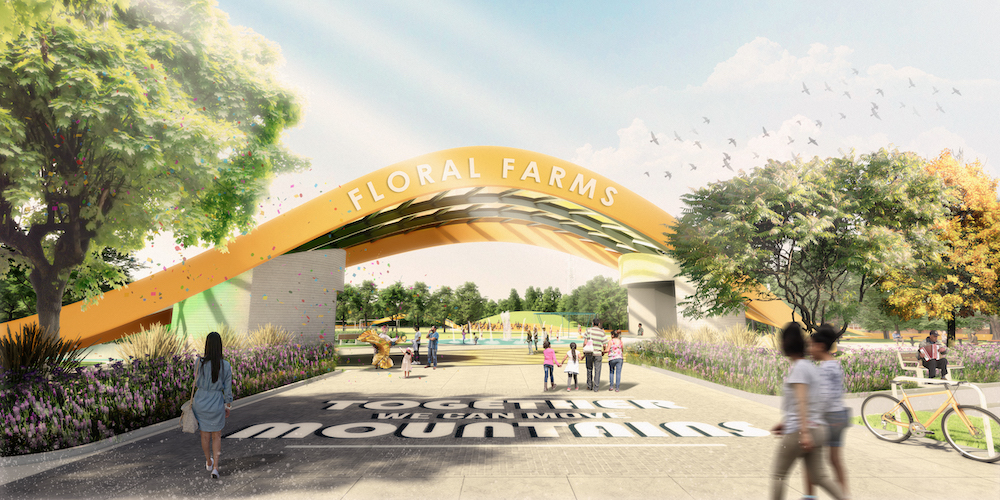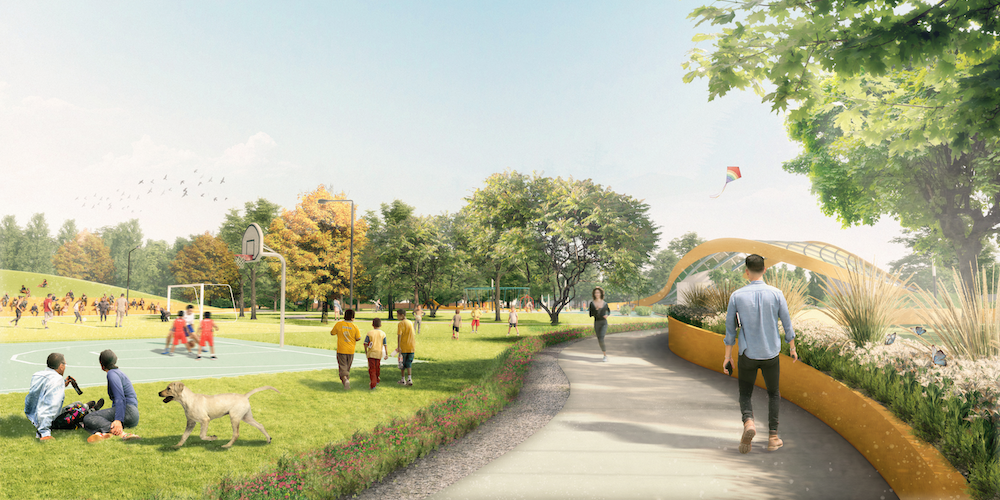Hope Comes to Floral Farms: Visions of a Park Where Shingle Mountain Once Stood
Marsha Jackson was delighted to see her neighborhood last week. About 50 people sat on folding chairs in a building on their neighbor’s property to see their vision of a park in renderings. It took years to get to this point, years of struggle to get the city to pay attention to the six-story shingle pile that lay next to their property. Jackson became her neighborhood spokeswoman for Floral Farms and later a plaintiff trying to get the courts to force someone to do something.
Finally they did. The city acquired the property and hired a contractor to transport 70,000 tons of gravel rubble to the landfill. The mountain has disappeared, but its remains – lead in the ground “above expected background levels”, the presence of arsenic – can still be found in the dirt. After the city issued its first environmental impact assessment, Jackson told us it wanted the city to “pay as much attention to people as it does to property.”
One fight after another. But Jackson and her partners haven’t stopped working: they want this land to be a park. Once the shingles began to pile up, it was difficult to get outside in this part of south Dallas, not far from the city’s southernmost border. Jackson had health problems, black smear on his lungs, shortness of breath, and rashes. Your neighbors, especially the children, stayed inside to avoid what was in the air.
Now they have something to look forward to. Jackson and her partners – Neighbors United / Vecinos Unidos, the Urban Research Initiative of Paul Quinn College, the Inclusive Communities Project, the nonprofit environmental activists Downwinders at Risk – partnered with the Dallas-based international architecture and design firm HKS, the started planning a park for his Citizen HKS charity.
They spent most of the year organizing community meetings (in English and Spanish) to find out what the neighbors wanted in a park. On Thursday, the community had the first opportunity to see their priorities visualized in renderings.
“The greatest joy yesterday was to see the neighbors with smiles on their faces. Usually they’re pretty calm and shy, but it’s just different, ”Jackson said on Friday. “Matt, you were down here. You can just see the difference. We are a big family and they are finally coming out of their shell. “
The park’s renderings showed a community garden and soccer field. A path runs the length of the 4.3 hectare site, accented by benches and surfaces for skateboarding and shady spots to relax. There is a playground and area for food trucks and another place where the community can actually meet. Jackson reminded me that there are no sidewalks there, so it’s difficult to walk here, especially considering her house on Choate Road is a tight turn off the busy State Highway 310. The suggested way would help. HKS’s plans also include a 14-foot tall mound of grass with seating at the bottom that is representative of both the past and the future.
HKS design researcher Erin Peavey, who led the design team, said she knew this had to be a project that needed to be healed. “You can do beautiful renders, but if the community wasn’t involved, how do you know they want to?” She said. “Power had been taken out of their hands for so long that the task was to give it back.”
A representation of the new park at Floral Farms in need of the city’s blessing.
Courtesy of HKS
Shingle Mountain is an unfortunate part of the neighborhood’s history. Jackson and most of her neighbors were there long before the illegal dump. In 1995 she bought a house to raise her children and horses. They enjoyed life 20 minutes south of downtown Dallas in a tree-lined part of town that felt like the countryside. In the years since she moved here, the city’s zoning regulations have welcomed industry and allowed illegal landfills and junkyards to spread.
Floral Farms is just north of Interstate 20. The town has been actively involved over the years in evicting residents, whether through zoning or significant domains.
Residents began moving here in the late 1950s, a few years after the city of Dallas annexed the country, according to a 1992 article in the Dallas Morning News. In the late 1960s there were about 100 families and two churches here. Local residents could fish in nearby Lemmon Lake, while children “played dodgeball with the gnarled fruits of the Bois d’Arc trees,” the article says. One resident remembers “flowers everywhere” so much that every spring the students “flood our teachers with bouquets of flowers”.
The city never invested in flower farms like anywhere else. The students were not taken to school by bus; You were walking down the Central Expressway, “hoping someone would pick you up,” recalled one resident.
After heavy rains drowned Simpson Stuart Road and flooded many surrounding houses, the city decided not to install flood protection. Instead, it stopped issuing building permits and prevented residents from repairing or renovating their properties. The city began buying houses in the 1970s; a resident moved here “because RL Thornton” [Freeway] went straight to my living room, “she told the newspaper. The displaced would soon be displaced again.
The city ran out of money and stopped buying real estate, so objectors stayed until the 1980s. During the neighborhood’s heyday, this news story describes the same conveniences that brought Jackson here in 1995: land, nature, comfort, and community.
It’s the people who made this room special, she says. In 1986 a man named JR Gilder started a black rodeo at the Pig Pen Arena near Simpson Stuart Road. Gilder had leased lots in the area and he sounds a lot like Jackson. “I wanted to go back to the country,” he told the newspaper, describing his decision to settle in Floral Farms. (Interestingly, another Gilder quote is reminiscent of the present: “If I weren’t out here, you probably wouldn’t be able to see the place. They’d dump here.”)
In the early 90s, the rodeo incorporated “black and white cowboys gallop”[ing] hunting cumbersome oxen together. ”Jackson remembers. It was a place where the church gathered. She would take her children who grew up on ropes and horseback riding. Years ago there was a small farm near her house where farmers grew cabbage and mustard greens and sold them at the farmers’ market.
“I’d like to see this come back,” says Jackson, “don’t just come down.” [neighboring State Highway] 310 and old scrapyards and junk cars to see. “
Peavey says she hopes the park project will channel some of what made the neighborhood great and provide residents with a place to be together. This gave rise to the idea for the community garden. The community also desperately needed a soccer field; HKS hopes it will attract teams from all over the city while also providing the neighborhood with a place to play. The second phase of the park will include an equine therapy center using an existing building on the property.

Erin Peavey, who led the design of the park with HKS’s pro bono arm, said she wanted him to help reclaim the neighborhood.
Courtesy of HKS
There is much to do. For one, Shingle Mountain was actually on two lots divided by a creek. The city acquired the first 4.2 acres, but the neighboring 2 acres are still privately owned and need to be acquired, which will likely only happen after the entire area is re-zoned. (The municipality has started applying for a reallocation to restrict industrial use, but there is no timeline for when the city will consider it.) The city must also rededicate the land to make a park possible.
In the meantime, the designs need engineering to create blueprints. Santander Bank threw a check for $ 100,000 for the cause last week, but donations are still to be raised. Evelyn Mayo, Paul Quinn’s Urban Research Initiative fellow, said she plans to convene all partners to determine next steps: Santander, the Dallas Regional Chamber, the Dallas Stars Foundation and HKS. They speak to Councilor Tennell Atkins in the hopes that he will be a champion for the estate’s next life, starting with redeveloping the land to remove lead and arsenic from the soil.
“It was just beautiful,” Mayo describes the unveiling on Thursday. “You don’t expect that to happen in the same year, that the mountain is gone and a vision to replace it so quickly. I think it’s a testament to everyone’s hard work. “
For a long time, Marsha Jackson and her neighbors have some hope. And it literally reclaims their neighborhood from flower farms; HKS put the name on an archway above the entrance. The concrete underneath also has a message: “Together we can move mountains.”
[ad_1]


